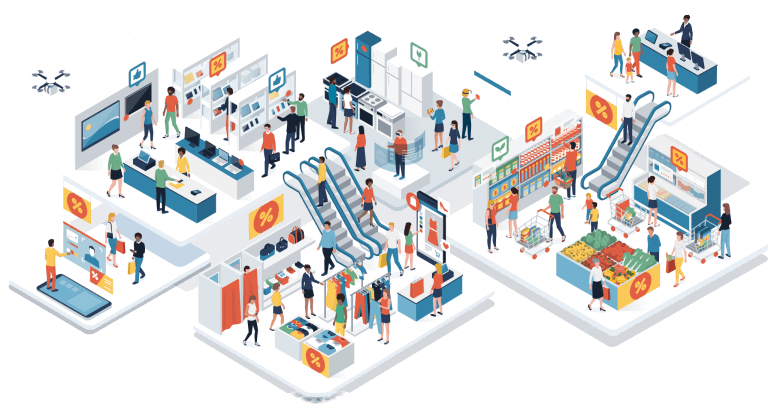Unlock untapped value through improved optimization and revenue
Harness the power of data analytics, AI, and machine learning
Retail & Consumer Goods
The retail and consumer goods industry is fiercely competitive and dynamic, with changing demographic profiles, changing levels of disposable income, ever-evolving customer preferences and continuous digital innovation. Companies need to constantly evolve and transform, to meet new challenges and remain competitive. That is where we come in!
At TCG Digital, we combine our expertise in the retail and consumer goods, with data analytics and digital transformation to offer both turnkey and custom solutions across the value chain to suit your organizational needs. Our services and solutions will help you adapt to an ever-evolving industry scenario and drive strategies to differentiate with your competitors.

Why TCG Digital
15%
Increase in Revenue
10%
Increase in Profitability
20%
Reduction in Customer Churn
TCG Digital comes with deep domain expertise and experience in retail and consumer goods along with a strong foundation in technology and data science skills. Our focus on hyper-contemporary technologies such as AI/ML, Blockchain, Cloud, Mobility, RPA, IoT and Cybersecurity help us deliver comprehensive solutions to our customers, leveraging flexible delivery models suited for various needs. We offer analytics and digital services to our clients, leveraging a rich library of pre-built accelerators on our end-to-end proprietary analytics platform— mcube™ that expedites the velocity to value for our customers.
How We Can Help
Customer Analytics
Leveraging our deep expertise in analytics and digital transformation, we can help you understand your customers better and have more relevant interactions based on the customer needs and preferences. We can provide critical insights that will help you:
Read MoreLess
- Increase the share-of-wallet from your existing customers
- Reduce customer churn
- Provide recommendations around next likely purchase
- Win back “lost” customerss
- Understand product affinity to recommend cross selling opportunities
- Increase outlet penetration
- Understand the voice of the customer through social media analytics
- Improve service centre efficiency
- Analyze complaints to improve customer satisfaction
- Identify niche/evolving customer bases
- Execute geo-fenced target promotions
Marketing and Sales Analytics
We leverage our analytics and big data capabilities to provide personalized recommendations around campaigns based on customer micro-segments and help formulate data-driven marketing and sales strategies. Our analysis can facilitate:
Read MoreLess
- Target marketing/precision marketing
- Promotional spend optimization
- Post-event analytics
- Channel optimization
- Omni-channel analytics
- Formulation of optimal pricing strategies
- Assessment of sales force productivity
- Assessment of brand productivity
- Sales forecasting and data-driven budgeting
Supply Chain Analytics
Our robust technology and predictive/prescriptive modeling capabilities can help you get complete visibility across your supply chain and help you optimize the network. Our analysis can drive:
Read MoreLess
- Improved demand forecasting
- Inventory optimization
- Supply chain cost optimization
- Improved efficiency in transportation
- Store segmentation analysis
- Root cause analysis for stock-outs
- Procurement optimization
- Dealer analytics
- Freight analytics
- Raw materials inventory management
- Wastage analysis
- Quality analysis
- Production planning and scheduling
Competitive Operations
We help our customers drive competitive operations, which is crucial in the retail and consumer goods world with its razor thin margins. We leverage our big data technology to analyze the complexities and help drive efficient operations at optimal cost-points. Our services and solutions can help with:
Read MoreLess
- Work force optimization
- Demand forecasting
- Inventory optimization
- Price optimization
- Data-driven budgeting
- Social media analytics
- Sales force productivity
- Production loss minimization
- Agile manufacturing
Merchandizing Analytics
Our robust technology, deep domain expertise and prescriptive modeling capabilities help drive strategies that make the right products available in the right place and at the right time. Our solutions in merchandizing include:
Read MoreLess
- Company/ BU sales performance
- Profitability analysis
- Growth analysis
- Employee performance analysis
- Own store performance analysis
- AR analysis/bad debt forecasting
- Deal effectiveness analytics
Performance Analytics
Leveraging our deep domain expertise in retail and consumer goods, we have a metric store of retail KPIs in our platform tcg mcube; that will help you track various KPIs connected with operations, finance, sales, marketing, customer service, customer loyalty, store management, etc. Using this library, our customers can perform quick analysis on trends, comparison with benchmarks, and drill-down on concern areas. Our services and solutions can help with:
Read MoreLess
- Publish performance data in public dashboards
- Make export-import trends across commodities, regions, and ports more accessible
- Modernize record management practices to proactively address information dissemination needs
Our Success Stories

Price optimization for a top multi-category retailer
Price optimization for a top multi-category retailer
Objective
A top retailer wanted to identify opportunities to increase profitability across categories without any adverse impact on revenue. The goal was to develop a recommendation engine to suggest optimal price points for each SKU factoring in demand price elasticity relationships, vendor side constraints, macro-economic conditions, competitor pricing, etc.
Our Solution
- Our price optimization module used historical transaction data to derive a price-demand relationship for each item using curve fitting and deep learning techniques.
- The optimal price is recommended (using LP/MIP algorithms) at which revenues or margin can be maximized.
- The solution factored in cost of manufacturing and cost of freight into pricing recommendations, along with competitor pricing information, seasonality, macro-economic factors, etc.
- The solution offered flexibilities for scenario analysis which significantly helps in a collaborative decision-making processes.
- The solution leveraged a self-learning approach and monitors results to continuously improve modelling accuracy.
The solution was built leveraging tcg mcube, our proprietary analytics platform that can analyse large volumes of data to drive accelerated insights. The built-in data models and data science algorithms drive velocity to value for our customers.
Project Impact and Outcomes
A data science-driven approach for pricing helped increase gross margin by 3% to 10% for various categories without any adverse impact on revenue.

Topic classification and sentiment analysis for a top retailer
Topic classification and sentiment analysis for a top retailer
A top retailer wanted to understand its customer sentiments to improve customer perceptions and drive differentiation strategies in the market. The goal was to drive brand strategies leveraging insights from social media analytics.
Our Approach
- Content from customer reviews, surveys, social media posts, etc. were leveraged.
- Our text classification engine (that leverages various supervised learning algorithms) was used to categorize each comment into classes such as customer service, pricing, in-store experience, etc.
- Our sentiment analysis engine used an ensemble of algorithms to arrive at a weighted sentiment score for each comment within each of the classes of comments.
- The solution was built leveraging tcg mcube, our proprietary analytics platform that can analyse large volumes of unstructured data to drive accelerated insights. The built-in data models and data science algorithms drive velocity to value for our customers.
- Revised brand strategy helped ameliorate customer sentiments, reduced churn by around 8% and increased revenue by 5%.

Demand forecasting and inventory planning for a top retailer
Demand forecasting and inventory planning for a top retailer
A top retailer wanted to reduce the inventory holding costs by leveraging improved demand forecasts and planning. The goal was to develop a tool to forecast future demand with minimal human interventions that would feed back into the system to help generate purchase orders (with store-wise allocations) based on demand projected and ordering frequency of the vendors.
Our Solution
- Our demand forecasting module leveraged an Ensemble approach with a library of algorithms.
- The MAPE on the training set and on the validation is considered for selecting the specific algorithm for a store and/or SKU.
- Additional considerations factored into the demand forecasts included:
- Effect of Day of the Week
- Effect of Promos/Festive Offers
- Stock-Out bias adjustments
- Seasonality Considerations
- Effect of Week of the Month
- Effect of Outliers/Spikes
- Effect of Known Lean Periods
- Effect of Complements/ Substitutes
- The solution leveraged demand forecasts and historical data to compute vendor lead times and fill rates, leading to re-computation and reassessment of optimum ordering quantity, safety stocks, etc.
Project Impact and Outcomes
- A data science driven approach led to improved accuracy on sales predictions and better inventory rules leading to improved inventory planning.
- The inventory holding cost decreased by over 4% without any compromise in service levels.

Driving supply chain efficiencies by optimal spares stocking for a top white goods manufacturer
Driving supply chain efficiencies by optimal spares stocking for a top white goods manufacturer
A leading white goods company wanted to drive efficiencies in the supply chain and recommend optimal spares stocking at the central repository, branches, and service franchises. The aim was to reduce holding costs without stock-outs or deterioration in service levels.
Our Solution
- The model forecasted spares consumption across the install base (existing as well as expected).
- An ensemble approach was used for the Predictive Modelling (using a library of algorithms) that auto selects the best fit predictive model for each spare part.
- The model factored in consumption trend variation by season, geography and machine type.
- Based on expected consumption and supply-side parameters such as inventory holding capacity, cost constraints, lead times, etc. the optimization engine recommended the optimal spares stocking at various points in the Supply chain using a Mixed Integer Programming approach.
Project Impact and Outcomes
- The recommendations from the solution helped in operational planning and minimized the risk of stock outs, balancing inventory holding costs.
- The implementation of these recommendations also increased customer satisfaction through reduction in call closure delays due to insufficient spares availability at franchisees.

Churn reduction for a top multi-category retailer
Churn reduction for a top multi-category retailer
A top retailer wanted to improve churn rates by leveraging data science driven insights. The goal was to understand each customer by creating behavioural cohorts and drive personalized campaign strategies to reduce churn.
Our Solution
- Our churn propensity computation module used a multi-model ensemble approach that included Logistic Regression, SVM, Boosted Decision Trees, Averaged Perceptron.
- Our customer segmentation module created customer micro-segments (cohorts) based on customer behavior and attributes, taking into consideration demographic data, shopping mission, average monthly spend, sentiments and feedback, basket preference, average time between visits, bill value as well as baskets.
- The customer micro-segments were used to devise intervention strategies(such as personalized churn reduction campaigns) for “high risk” customers in each target cohort.
- The solution leveraged a self-learning approach to refine recommendations and strengthen propensity rules.
Project Impact and Outcomes
Rollout of churn prevention campaigns based on data science driven insights helped reduce churn rate by over 20% within 3 months.

Wallet share increase for a top multi-category retailer
Wallet share increase for a top multi-category retailer
A top retailer wanted to increase revenue from existing customer base by capturing an increased share-of-wallet from such customers. The goal was to understand each customer by creating behavioural cohorts and drive personalized campaign strategies for cross-sell and up-sell.
Our Solution
- Our customer segmentation module created customer micro-segments (cohorts) based on customer behavior and attributes, taking into consideration demographic data, shopping mission, average monthly spend, sentiments and feedback, basket preference, average time between visits, bill value as well as baskets.
- The customer micro-segments were used to devise intervention strategies (such as personalized wallet-share increase campaigns) for customers in each target cohort.
- Market-basket analysis was leveraged to identify groups of products that sold together.
- Top products for each target customer was identified based on his/her past purchases as well as purchases by similar customers (in the same cohort).
- The solution leveraged a self-learning approach to refine recommendations and strengthen propensity rules.
Project Impact and Outcomes
Rollout of wallet share increase campaigns based on data science driven insights helped increase revenue from existing customer base by over 12% in 3 months.

In-house brand sale increase for a top multi-category retailer
In-house brand sale increase for a top multi-category retailer
Objective
A top retailer wanted to increase sales for in-house brands as these brands drove higher profitability for the retailer. The goal was to understand each customer by creating behavioural cohorts and assess the propensity of each customer in a cohort to buy in-house brands.
Our Solution
- Our propensity computation module used a multi-model ensemble approach that included Logistic Regression, SVM, Boosted Decision Trees, Averaged Perceptron to identify in-house brand purchasing propensity for active customers.
- Our customer segmentation module created customer micro-segments (cohorts) based on customer behavior and attributes, taking into consideration demographic data, shopping mission, average monthly spend, sentiments and feedback, basket preference, average time between visits, bill value as well as baskets.
- The customer micro-segments were used to devise intervention strategies (such as personalized campaigns) for customers in each target cohort.
- Propensity models were used with a feedback loop that strengthened or weakened propensity scores with each transaction within an observation timeframe.
The solution was built leveraging tcg mcube, our proprietary analytics platform that can analyse large volumes of data to drive accelerated insights. The built-in data models and data science algorithms drive velocity to value for our customers.
Project Impact and Outcomes
Rollout of in-house brand related campaigns based on data science driven insights helped increase sales of in-house brands by over 15% within 3 months and this resulted in an overall profitability increase of approx. 5%.

Trade scheme effectiveness analysis for a top CPG company
Trade scheme effectiveness analysis for a top CPG company
A leading white goods company wanted a solution to assess the effectiveness of various trade schemes given to dealers and distributors with the overall aim of scheme rationalization and ROI maximization.
Our Solution
- The solution used multivariate analysis to understand the impact and effectiveness of existing schemes.
- The effectiveness was assessed based on the ability of any scheme to drive a revenue increase, impact on gross contribution and improvement in saliency.
- The effectiveness was assessed for each region and product category separately. It was also assessed at a dealer category level.
- Using the above analysis, the solution recommendations include the optimal mix of schemes for a defined business goal, factoring in impact of festive periods and seasonality.
Project Impact and Outcomes
- Our approach drove the following key insights for the business.
Increase in overall gross contribution - Overall scheme rationalization by removing non-effective schemes.


